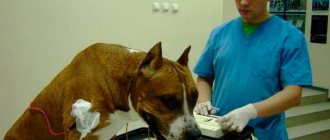Helping a dog with a heart condition
The heart is considered by many to be the main organ. Of course, the body cannot live without the liver, kidneys, and stomach, but only cardiac arrest causes instant death. Therefore, life is very difficult for a dog with a heart condition. It requires your constant care and guardianship and immediate assistance in critical situations.
Ambulance for a four-legged friend
Video “Heart failure in dogs”
Comments and Reviews
Heart failure
This term refers to a condition when the heart is unable to fulfill its direct “responsibility”, that is, to supply organs and systems with fresh arterial blood. Naturally, it is impossible to ignore or not notice heart failure in a pet for a long time. This could end very badly.
Causes
Heart failure in dogs is a consequence of various heart diseases. It is important to understand that the occurrence of heart disease does not immediately lead to the development of heart failure. For a sufficiently long period of time, heart disease can be asymptomatic, without affecting the general condition of the animal. This is called the compensation stage.
And only when the body’s compensatory mechanisms are exhausted and various symptoms of heart failure in the animal begin to appear, the most common of which are presented below.
- Mitral valve endocardiosis. This is the most common cardiac pathology and is more common in small and medium breed dogs. Breeds such as Dachshunds and Spaniels are especially prone to endocardiosis. The causes of endocardiosis have not been fully established, but there is a clear genetic predisposition. During the course of the disease, the valves between the chambers of the heart thicken and become deformed. The severity of endocardiosis depends on the degree of valve deformation.
- Dilated cardiomyopathy. A disease common to large and giant breeds. Dobermans have a special tendency. The pathology also has a genetic predisposition. This disease is characterized by impaired myocardial contractility and, as a consequence, a progressive decrease in cardiac output.
- Congenital heart defects. They are a fairly rare pathology, accounting for about 2% of all cardiomyopathies. Unlike other heart diseases, heart defects appear at an early age.
- Dirofilariasis. A parasitic disease caused by roundworms that parasitize the right side of the heart and the pulmonary artery system. The disease is transmitted by the bites of infected mosquitoes. Symptoms depend on the degree of infestation, that is, on the number of parasites living in the heart.
Healthy and modified heart
In principle, it can be noted that heart failure in dogs is an age-related pathology. As a rule, the age of patients is over 7 years. Therefore, you need to especially monitor your elderly pet, provide assistance to it, and regularly show it to a veterinarian-cardiologist.
Symptoms
Heart failure is characterized by a slow, increasing development of symptoms, the main of which are:
- exercise intolerance;
- cough;
- shortness of breath, even at rest;
- pallor of the mucous membranes;
- fainting.
In severe forms of heart failure, ascites may develop - abdominal dropsy and pulmonary edema. In Dobermans, unfortunately, dilated cardiomyopathy can develop asymptomatically and end in sudden death.
Treatment
Unfortunately, heart disease in animals is incurable. If a dog shows symptoms of heart failure, it requires help and lifelong treatment. It is aimed at reducing the severity of symptoms and improving the animal’s quality of life.
The main groups of drugs used to treat heart failure:
- Diuretics. They are used in the vast majority of cases, and the smallest dose that has an effect is selected. Diuretics help remove excess fluid and prevent the development of congestion in the lungs.
- Antiarrhythmics. They are also used for treatment quite often when there are disturbances in heart rhythm and pumping function of the heart.
- Angiotensin-converting enzyme inhibitors. They are used in complex treatment to reduce the pathological accumulation of fluid in the body.
- Inotropic drugs, that is, drugs that increase the contractility of the heart muscle. They are expensive, but significantly improve the quality of life of animals even at the most severe stages of heart disease.
- Omega 3-6 fatty acids. They are a food additive that, when used over a long period of time, has an antiarrhythmic effect and increases life expectancy. They are the only vitamins that actually work for the heart.
Common pathologies
According to the frequency of damage, heart diseases in dogs are arranged in the following sequence:
Endocardiosis is deformation of the heart valves, which leads to blood stagnation. May cause pulmonary edema. The most common pathology of all cardiac problems in dogs.
Cardiomyopathy is damage to the heart muscle: the myocardium is replaced by connective tissue or even degrades. There is a failure in the pumping function of the heart.
Congenital defects are a fairly large group of anomalies that occur due to pathologies in the development of cardiac structures during the prenatal period.
Arteriosclerosis is cholesterol deposits on the walls of blood vessels.
Dirofilariasis - the roundworm Dirofilaria Immitis lives in the heart of a dog. Infection occurs from a mosquito bite. Adult nematodes can live actively for up to 10 years, which causes irreversible damage. In cases of severe infection, the helminths with their mass clog the blood vessels, which can result in the death of the dog.
Pericarditis is an inflammation of the outer lining of the heart (the lining), in which fluid can accumulate in the pericardial area. Often occurs as a complication after suffering from pleurisy, purulent pneumonia, plague, myocarditis. A deadly disease.
Myocarditis is inflammation of the myocardium. Similarly, it often appears as a secondary complication after parvovirus enteritis, Lyme disease, leptospirosis or distemper.
Endocarditis is inflammation of the inner lining of the heart. When the disease progresses in a chronic form, a heart defect occurs, which leaves very little chance for life.
In fact, the liver heart disease that dogs are susceptible to is much more extensive. And using the example of the above pathologies, only the most frequent ones in terms of the number of requests are shown.
Reference. Dogs cannot have myocardial infarction. Never. Simply because they do not have atherosclerosis, which provokes a heart attack in people. This is explained by completely different lipid metabolism and nuances of blood circulation. Every similar diagnosis given to a dog is fundamentally wrong.
In puppies
Heart problems in a dog during puppyhood indicate a congenital defect in its structure. The anomaly is either genetic in nature, or during pregnancy the bitch suffered severe infections or poisoning.
Without careful monitoring of the puppy's heart condition and without proper treatment, in most cases the life expectancy is very short.
The most common congenital defects recorded are:
Open Botallov duct. After birth, the puppy does not close the arterial duct between the aorta and the pulmonary artery. There is a release of blood from the aorta into the pulmonary artery, which greatly overloads the blood vessels of the lungs and causes left-sided heart failure. The prognosis is often unfavorable.
Open oval window. Atrial septal defect. May cause right-sided heart failure. The forecasts are very cautious.
Pulmonary artery stenosis. The pulmonary vessels do not receive enough blood due to insufficient ejection from the right ventricle.
Anomaly of the aortic arch. The aorta is pathologically located to the right of the esophagus. For this reason, the Botallus duct tightens the esophagus, and food accumulates in its precordial part. With adequate and very timely treatment, the prognosis is favorable.
Narrowing of the aortic mouth. Obstructed blood flow from the left ventricle to the aorta. Oxygen deficiency can cause myocardial ischemia and, as a consequence, arrhythmia. The diagnosis does not exclude sudden death.
In old age
Most heart pathologies become especially pronounced in dogs after 6-7 years of age. The situation is significantly aggravated by poor nutrition, bad teeth, regular stressful situations and insufficient physical activity. That is, unsatisfactory pet care.
However, even the most loving owner cannot always detect a problem at an early stage. Because there are no visible symptoms at first. Only during routine vaccination, preparation for any operation, or simply during an examination, can a cardiac pathology be discovered completely by accident.
In middle and old age, the dog is susceptible to any of the diseases described above. A particularly high mortality rate is observed due to chronic heart failure - 43% of the total number of heart pathologies.
Heart attack
It is one of the most common misconceptions that dogs are susceptible to heart attacks.
The fact is that a heart attack in a dog can only develop against the background of atherosclerosis. But it practically never occurs in dogs. Therefore, pulmonary edema is recognized as the main critical condition that can occur in acute heart failure. It poses a direct threat to life in the absence of adequate treatment.
Provoking factors
The cause of the development of a critical condition in the form of pulmonary edema may be prolonged neglect of heart failure and all those diseases that cause it. This also occurs when the heart is so pathologically altered that it cannot perform its function without supportive drug therapy. In such cases, acute pulmonary edema occurs due to the overflow of arterial vessels, capillaries and veins with blood, which cannot always be stopped. For more information about heart attack or pulmonary edema, watch the video below.
Causes of fainting in dogs
Examples of diseases that can cause loss of consciousness:
Heart disease.
These are usually congenital heart disease (birth defects of the heart), acquired heart disease (heart failure), cardiovascular disease, heart tumors, pericardial disease (disease of the heart wall), and primary cardiac arrhythmias (irregular heart rhythm). When blood is not pumped through the body properly, the brain is most vulnerable. It may momentarily run out of oxygen, causing loss of consciousness or fainting.
Fainting (syncopation).
Fainting may occur due to disturbances in blood pressure control mechanisms (neurocardiogenic syncope). This condition can be difficult to diagnose without a complete assessment of the patient.
Blood diseases.
These include internal bleeding from a ruptured tumor or organ, severe anemia, leukemia, and polycythemia (abnormally thick blood caused by excess red blood cells). To function properly, the brain and muscles need an adequate amount of blood (and oxygen carried by red blood cells). Otherwise, diseases may develop.
Respiratory diseases.
This category of diseases can also include blockage of the throat by a foreign object or paralysis of the larynx, which causes the inability of air to enter the lungs. Other causes include respiratory illnesses such as bronchitis, tracheal disease, pneumonia, or pulmonary edema (fluid in the lungs). BE CAREFUL! Many conditions cause choking during loss of consciousness, and without a foreign object in the mouth or throat. Don't risk getting bitten by trying to remove an object from your throat that isn't there. “A dog is choking on something” is a general description of the symptoms of pet owners who are having trouble breathing without a foreign object in the mouth or throat.
Diseases of the nervous system.
These are usually the main causes of a dog losing consciousness. These include fibrocarthyhalogen emboli (when clots in the bloodstream damage the spinal cord), intervertebral disc disease (a “prolapsed disc” in the neck or back), degenerative myelopathy (degeneration of the spinal cord), and myasthenia gravis (impaired conduction from nerves to muscles). In diseases of the spinal cord and muscles, the consciousness and mental abilities of animals generally do not change during loss of consciousness, whereas in diseases of the brain, disturbances of consciousness, such as convulsions, may occur during loss of consciousness.
Musculoskeletal diseases.
These include hip dysplasia (arthritis of the hips), lumbosacral diseases (arthritis of the lower back) and others. Typically, with musculoskeletal diseases, there may be preliminary symptoms, such as limping, difficulty standing up, or the inability to sit or jump, that have been present and developed (worse) in the days, weeks, or months before the loss of consciousness event.
Toxicity.
Many types of poisoning can cause sudden weakness and collapse. If your dog has been exposed to any substance that is poisonous, such as rat poison and snail/slime poison, you should tell your veterinarian, even if the poisoning may have occurred several days ago.
Medicines.
A simple example would be an overdose of insulin causing excessively low blood sugar. Many medications that can be taken by mistake by your dog or maliciously given by someone can lead to low blood pressure. Likewise, some veterinary prescription drugs can cause low blood pressure and loss of consciousness.
Acute cardiovascular failure in dogs
#image.jpgAcute cardiovascular failure, or collapse, develops in dogs after severe blood loss, poisoning and infectious diseases.
The dog is lethargic, lying down, breathing shallow and frequent. The mucous membranes are very pale. The pulse is not detected.
First aid consists of identifying and eliminating the cause that caused this condition. The dog should be given rest, heating pads or bottles of warm water should be placed on the limbs, the animal should be covered and given warm tea or sweet, strong brewed coffee.
After providing first aid, urgently call a specialist or take the dog to a veterinary hospital, while trying to disturb the animal as little as possible.
Help at home if your dog loses consciousness
- If it's a severe collapse, don't panic. Examine your dog carefully. Notice if your pet loses consciousness. Pay attention to how long your pet was unconscious, as well as his behavior after. If your dog is unconscious, try to feel the heartbeat on the left side of the chest. If your pet is dazed and aggressive, be careful not to bite you. Call your veterinarian and explain what happened.
- If your dog is unable to get up, be prepared to take your pet to the hospital immediately after talking to your veterinarian.
BE CAREFUL! Animals who experience acute loss of energy may be disoriented, confused, or aggressive throughout the illness and during recovery. Therefore, they can accidentally bite and harm even the closest person.
- Dogs susceptible to collapse often behave normally within minutes. In such cases, a veterinary examination is still necessary to discover the cause and try to determine whether future attacks are likely.
- If your pet seems completely healthy, try keeping records. Remember what your last attack was like. Did this happen in a standard situation (for example, chewing on a ball or toy)? Did the attack occur during normal movements or vigorous exercise? How long did the last collapse last? Did your pet lose consciousness? How did the dog behave after? This information will be very helpful to your veterinarian.
- If the collapse continues, it is usually best to contact your nearest veterinary clinic immediately.
- Self-resuscitation can cause damage to an internal organ if done incorrectly.
Treatment of heart failure in older dogs. How to Treat Heart Failure in Dogs
How to Treat Heart Failure in Dogs
Acute infectious diseases, injuries, blood loss, heavy physical activity lead to the development of heart failure in dogs. Find out how to treat a dog's heart.
Heart failure is a condition of the body in which the heart is unable to provide normal blood circulation. In turn, this leads to a deterioration in the blood supply to organs, congestion, which ultimately leads to pathological changes in the myocardium. Thus, deterioration of heart function leads to disruption of the heart muscle. This is most often observed in older and larger dogs. Acute infectious diseases, injuries, blood loss, heavy physical activity lead to the development of heart failure in dogs.
The heart becomes unable to pump the volume of blood, with the appropriate amount of oxygen and nutrients, that is necessary for the body's tissues. This results in signs such as swelling, shortness of breath, cardiac cough, decreased appetite in dogs, loss of muscle mass, fainting, lethargy and weakness in dogs. But you should also remember that in the early stages of the disease these symptoms may not appear. Only with the development of pathology do they become obvious. The following symptoms may also alert the dog owner: increased dog fatigue, thirst, rapid breathing, even in open spaces, noisy breathing with wheezing, blue tongue after exercise, coughing when moving or at rest.
Heart failure can be either a congenital defect or acquired (due to previous infectious diseases of the dog), and manifests itself in older dogs. The diagnosis is easy to make based on clinical signs. The dog is lethargic and gets tired quickly. With exertion, shortness of breath and tachycardia increase. Dry and moist rales are heard in the lungs. Swelling of the extremities and dewlap, ascites occur. Often the heart increases in volume.
Heart failure in dogs can quickly develop into chronic disease. In this case, therapy should be aimed at eliminating or minimizing clinical symptoms in dogs, protecting blood vessels, heart, kidneys, brain, improving the quality of life, and increasing the dog’s life expectancy.
Possible causes of fainting in dogs
The causes of sudden fainting in a pet can be very diverse, however, most often they are directly related to cardiac activity. So, the following factors can cause an animal to faint:
- heart rhythm disturbances;
- lung diseases;
- severe blood loss;
- a sudden change in body position (for example, a sudden rise from a lying state);
- poisoning with antispasmodics or diuretics;
- various vascular disorders (sharp dilatation or constriction of blood vessels) that can cause fainting in dogs of any age.
- tachyarrhythmia;
- venous congestion, causing bradycardia;
- bradyamitry;
- poisoning of the body with toxins;
- a sharp decrease in hemoglobin, red blood cells, or platelets;
- constant fatigue;
- a sharp drop in blood sugar;
- long stay in a stuffy room;
- stress;
- shock;
- hypothermia of the body;
- heatstroke;
- neurogenic changes in the central nervous system;
- shock;
- prolonged fasting;
- hypothermia.
Fainting caused by certain disturbances in the functioning of the heart is the most dangerous. In some cases they can even lead to death.
Symptoms and treatment of heart failure in dogs
Heart failure practically never occurs as an independent disease.
It is accompanied by other diseases and infections of internal organs. The disease is very common. Horses, cats, and dogs often suffer from it. Heart failure in animals often appears at the age of six. However, in some cases it can appear at six months of age. Some small dog breeds, such as cocker spaniels, poodles, and Yorkshire terriers, are predisposed to this type of disease.
Treatment
Cardiology in veterinary medicine, in contrast to heart treatment in humans, lags very far behind in the development of some new methods and technologies.
Replacing a valve or performing an organ transplant on any dog in need remains impossible. Only drug therapy remains available. Therefore, there are certain difficulties in treating a dog’s heart.
Firstly, each drug has its own letter evidence index:
A - proven in animals.
B - proven in humans.
C - there is no evidence, a positive effect is possible purely theoretically.
D - the drug has been proven to be completely ineffective.
And here, at the stage of drug selection, it is very often necessary to prescribe drugs from groups B and C, because there are no reliable tests on animals with a similar pathology.
As an example, standard tactics to combat chronic heart failure:
- Inotropic stimulation (for active contractions).
- Removing excess blood volume using diuretics.
- Impact on hemodynamics.
- Neurohumoral unloading.
For these purposes, ACE inhibitors, Veroshpiron, Vetmedin, Furosemide, Digoxin are used.
Secondly, not every veterinary clinic has at its disposal all the equipment necessary for diagnosis. This is another reason for the weak positive results.
For example, an electrocardiogram is not an expert method for making a diagnosis. With the help of an ECG you can see only certain assumptions and probabilities, but not a detailed result.
And all the subtleties of a cardiac anomaly can only be shown by digital radiography, but, unfortunately, not all veterinary specialists still use this particular diagnostic method.
How does heart failure manifest in dogs?
If your dog shows the following signs of illness:
- heavy breathing appeared with little physical activity;
- the animal breathes with an open mouth;
- the inner surface of the mouth acquires a bluish tint;
- there is an increase in abdominal volume with a sharp decrease in appetite;
- the appearance of swelling on the paws;
- if the dog sits with its paws spread wide and at the same time sticks out its chest;
- a paroxysmal cough appears;
- there is pain in the area of the scapula and left shoulder;
- the appearance of pinkish foam in the corners of the animal’s mouth.
All these signs are very alarming bells of the emergence of serious deviations in the dog’s health.
Treatment of acute heart failure
The treatment package directly depends on the underlying disease. What is:
- the underlying disease is treated;
- blood pressure is maintained at normal levels;
- arrhythmia is eliminated;
- liver support is provided;
- the work of the myocardium is facilitated by drugs;
- swelling of the lungs is prevented and eliminated;
- maximum limitation of physical activity during treatment;
- proper diet. We recommend special Cardiac Canine wet food, which has a reduced sodium content.
Let's take a closer look at each stage:
Treatment of the underlying problem involves getting rid of acute heart failure. How to treat this disease? This refers to the use of medications that improve blood supply to the heart muscle. The drugs Trimetazidine, Mexicor and others are used. Myocardial nutrition is enhanced with Asparkam and adenosine triphosphoric acid (ATP).
Sometimes you can't do without antibiotics. An examination by a veterinarian is necessary to determine the stage of the dog's disease and select appropriate medications.
Medicines to eliminate the animal’s arrhythmia are selected based on the ECG.
If liver function is severely impaired, herbal tablets are used: Karsil, Silibor and others.
You can facilitate the work of the myocardium using a set of measures:
- enhance myocardial contraction with the help of cardiac glycosides. These include Digoxin, Strophanthin and others;
- dilate blood vessels based on ECG with drugs Nitroglycerin, Apressin and others;
- reduce the sensitivity of the heart muscle to stress hormones with beta-blockers such as Oxprenolol.
Pulmonary edema syndrome can be eliminated with diuretics such as Furosemide, Veroshpiron or an intravenous solution of 40% glucose. Diuretics are used to treat edema. Stress and strain are prohibited.
Heart failure, as we have already said, is a consequence of heart disease.
Is it possible to prevent your pet from getting sick?
It is impossible to protect your pet from heart disease with 100% certainty. But there are certain measures that will reduce the risk, as well as find pathology at the very beginning of its development:
- Take your dog for annual checkups to the veterinarian.
- When you reach the age of seven, get an ECG to check your heart function. Repeat the examination once a year.
- Avoid obesity - this is a big burden on the heart.
- Do not give excessive physical activity, everything should be in moderation.
- Try to walk your dog more in the summer, but do not force him to run or do tricks.
- Feed the animal fully.
This will help maintain the dog's health at the proper level. And even if problems begin, the owner will immediately notice them by changes in well-being.
How long do dogs with this problem live?
The death of an animal can occur about a month and a half from the moment of maximum reduction in the ability of the heart to pump blood through itself, or the animal may suffocate due to pulmonary edema. Animal mortality due to heart failure is very high (about 70%) even with treatment. The main reason for such a high mortality rate is the fact that dog owners, as well as other animals, notice the symptoms of this disease very late. And the help of a doctor in this case may no longer be needed.
Acute cardiovascular failure in dogs
#image.jpgAcute cardiovascular failure, or collapse, develops in dogs after severe blood loss, poisoning and infectious diseases.
The dog is lethargic, lying down, breathing shallow and frequent. The mucous membranes are very pale. The pulse is not detected.
First aid consists of identifying and eliminating the cause that caused this condition. The dog should be given rest, heating pads or bottles of warm water should be placed on the limbs, the animal should be covered and given warm tea or sweet, strong brewed coffee.
After providing first aid, urgently call a specialist or take the dog to a veterinary hospital, while trying to disturb the animal as little as possible.










